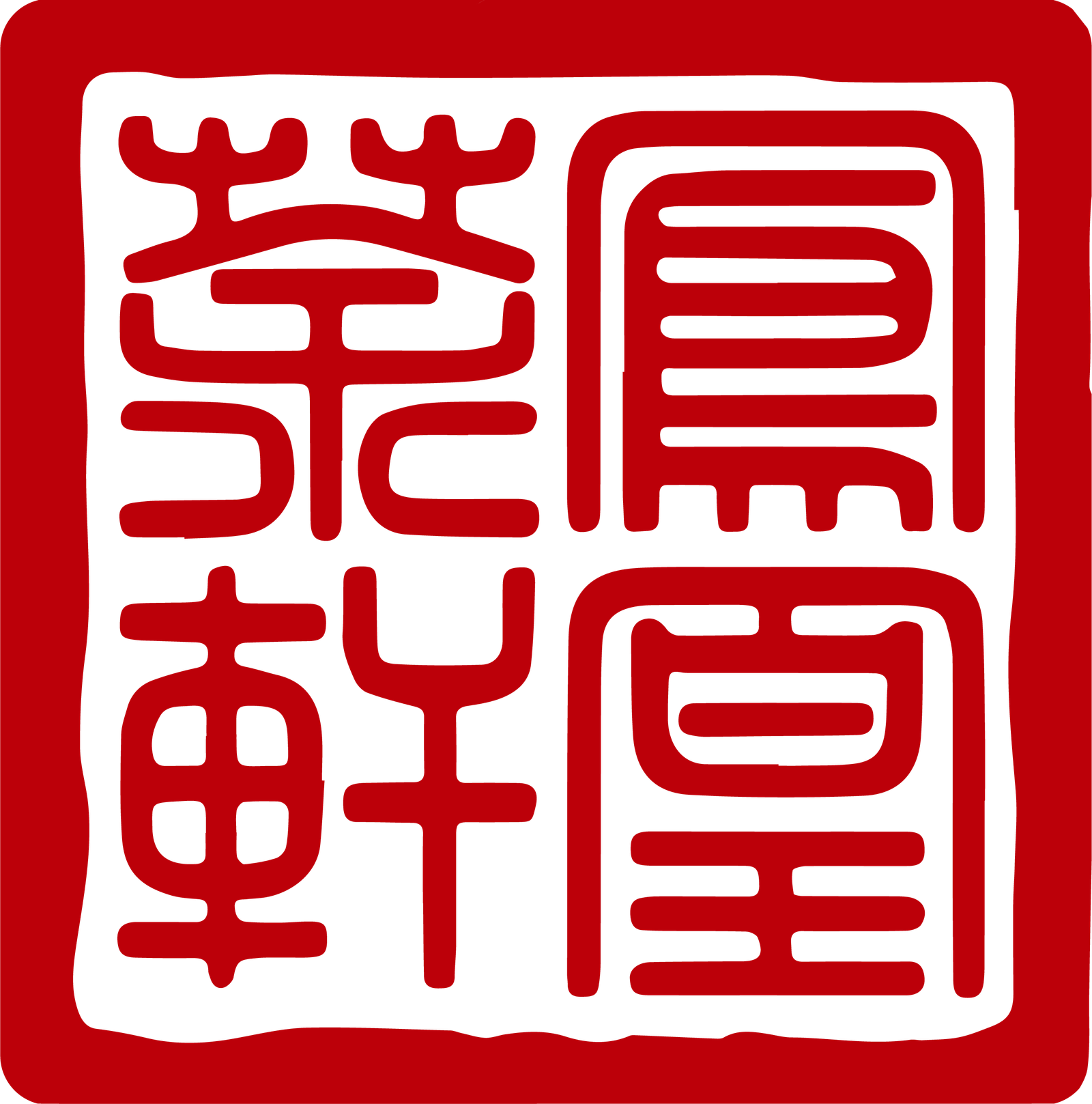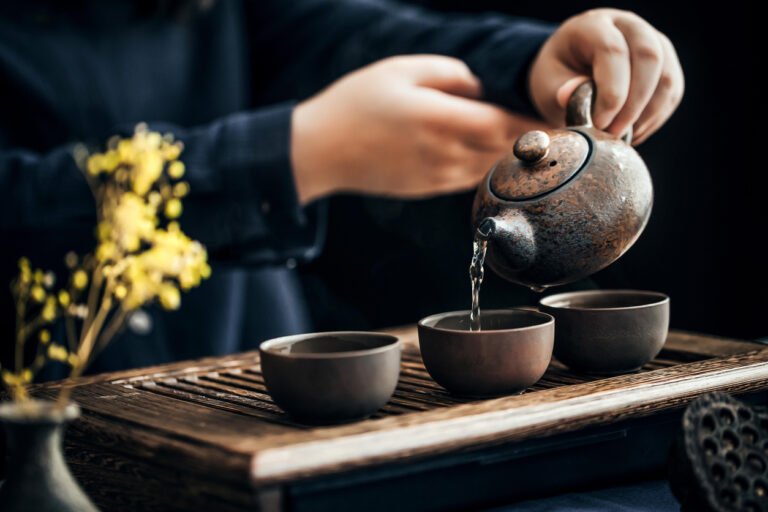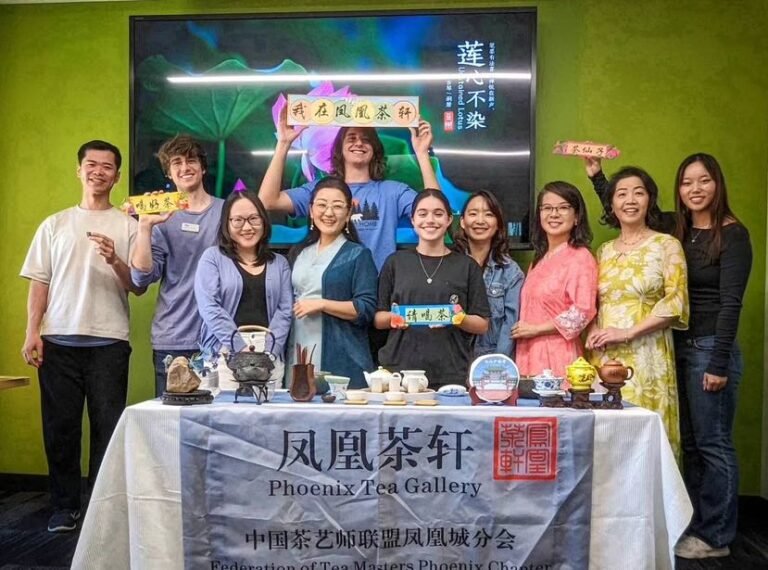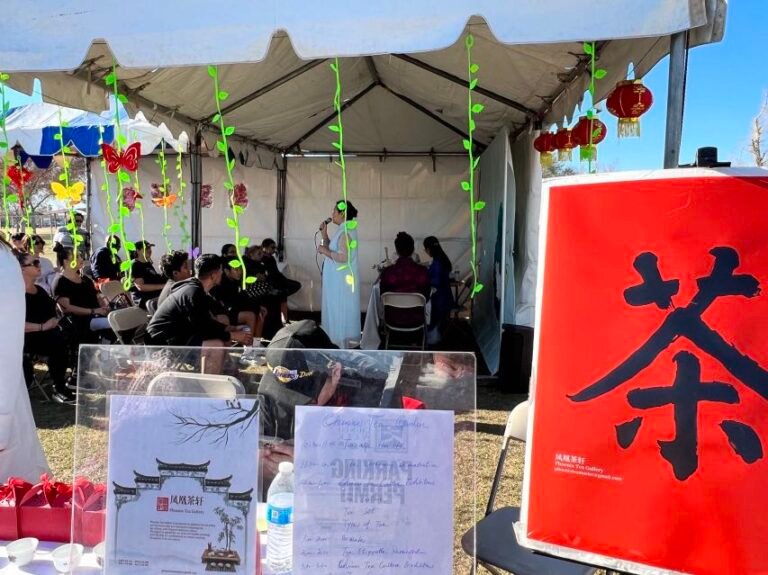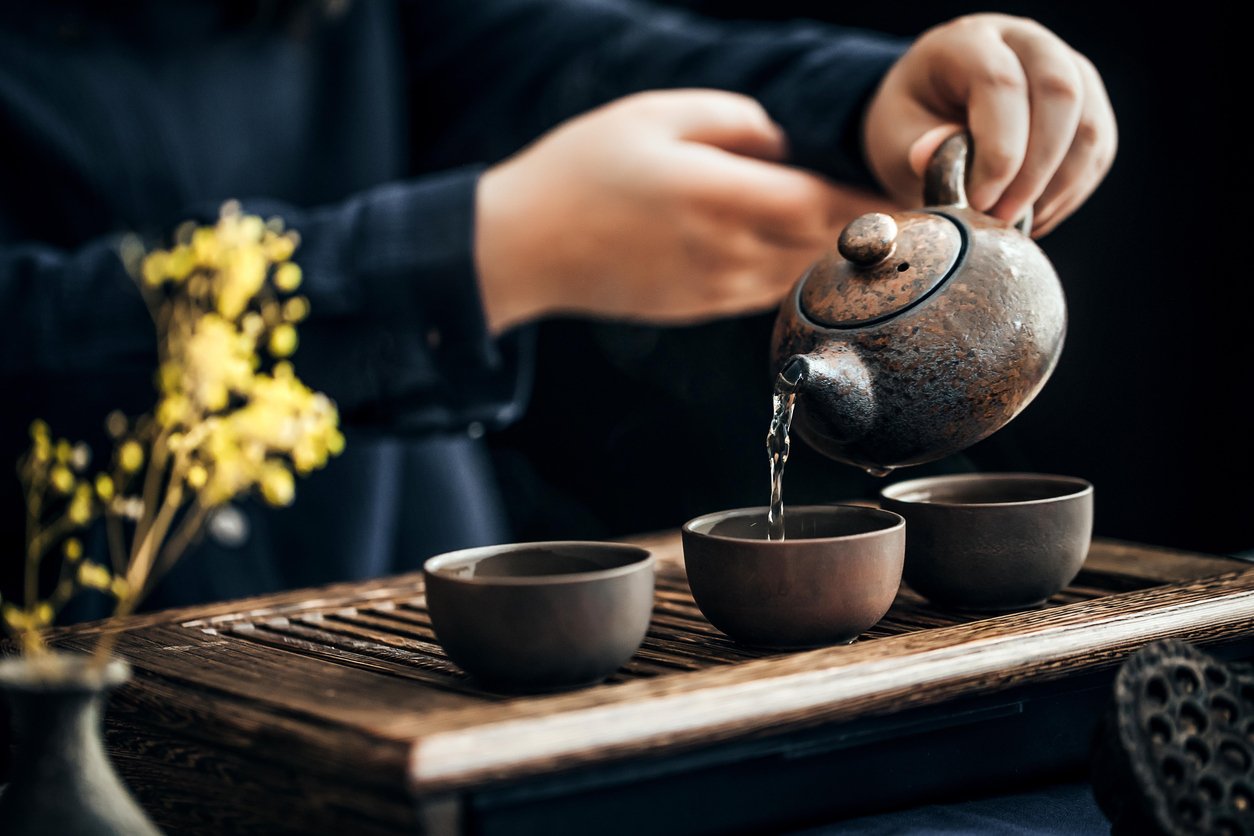
- 世界上第一部( )的作者是陆羽。
A、茶书
B、经书
C、史书
D、道书 - 好茶的评判标准不能从茶叶外形的匀整、色泽、净度和内质的( )去判断。
A、汤色
B、叶底
C、品种
D、香气 滋味 - 什么朝代饮用茶叶主要是散茶?
A、明代
B、宋代
C、唐代
D、汉代 - 红茶制作时冲泡用水的水温以( )为宜。
A、10-30℃
B、30-60℃
C、60-90℃
D、90-95℃ - 紫砂壶起源于中国哪个朝代?
A、唐朝
B、北宋
C、明朝
D、清朝 - 铁观音的香气馥郁幽长,滋味醇厚鲜爽回甘,( ),汤色金黄清澈明亮。
A、音韵显
B、岩韵显
C、青味显
D、酸味显 - 普洱茶主产于( )省。
A、海南
B、湖南
C、广西
D、云南 - 潮汕工夫茶被誉为中国茶道的“( )”。
A、始祖
B、活化石
C、代表
D、真工夫 - 香港的早茶一般为一壶茶配合吃少量的食物,称之为饮茶的“( )”。
A、一壶两件
B、一盅两件
C、一壶两盅
D、一盅两杯 - 茶叶中的 ( )是抗氧化剂,具有防衰老的作用。
A、茶多酚
B、维生素A
C、维生素H
D、维生素B - 由于舌头各部位的味蕾对不同滋味的感受不一样,在品茶汤滋味时,应该怎样才能充分感受茶中的甜、酸、鲜、苦、涩味?
A、含在口中不要急于吞下
B、在品茶汤滋味时,将茶汤在口中停留,并使之与舌的各部位打转,可以让舌头的不同部位充分接触茶汤
C、立即咽下
D、小口慢吞 - 南疆的维吾尔族喜欢用哪种长颈茶壶烹煮清茶?
A、铜制
B、银制
C、铝制
D、锡制 - 欧洲第一个喝茶的国家是?
A、荷兰
B、意大利
C、英国
D、法国 - 18世纪初1701年一部喜剧《茶迷夫人》是属于哪个国家?
A、法国
B、德国
C、荷兰
D、英国 - 以下哪些是不属于茶叶滋味物质?
A、茶红素
B、茶黄素
C、氨基酸
D、叶绿素 - 第一个从中国学习饮茶,把茶种带回日本的人是谁?
A、玄奘
B、最澄
C、郑和
D、 皎然 - 海南五指山红茶是否获得过国家地理标志产品认证?
A、是
B、否 - 茶叶的提神功效主要是以下哪种起作用?
A、氨基酸
B、儿茶素
C、咖啡碱
D、茶黄素 - 茶树性喜温暖,湿润,在北纬45°和南纬多少度之间都可以种植?
A、50°
B、45°
C、40°
D、38° - 茶叶的原产地在哪里?
A、日本
B、印度
C、中国西南地区(云贵川)
D、中国江南地区 - 目前有多少个国家种茶?
A、30
B、64
C、75
D、121 - 日本人和韩国人讲究饮茶,注重饮茶礼法,茶艺师为其服务时应注意( )
A、茶水比例
B、用水选择
C、泡茶规范
D、茶叶用量 - 西湖龙井干茶叶外形属于
A、朵形
B、扁平形
C、条索形
D、卷曲形 - 茶圣是指以下哪一位?
A、神农
B、皎然
C、卢仝
D、陆羽 - 全球茶叶出口总量排第一的国家是?
A、肯尼亚
B、印度
C、斯里兰卡
D、中国 - 在茶的对外传播中,最早移植中国茶的是?
A、日本
B、印度
C、斯里兰卡
D、朝鲜半岛 - 黑茶属于以下哪种工艺?
A、轻发酵茶
B、后发酵茶
C、不发酵茶
D、全发酵茶 - 以下哪种是茶树不喜欢的条件?
A、光
B、酸
C、涝
D、温 - 斟茶时杯中茶汤应为几分满?
A、5分满
B、7分满
C、8分满
D、全满 - 红茶属于以下哪种茶?
A、不发酵
B、微发酵
C、半发酵
D、全发酵
- The author of the world’s first ( ) is Lu Yu.
A. Tea book
B. Classic
C. Historical book
D. Taoist book - The quality of good tea cannot be judged solely by its uniform appearance, color, cleanliness,
or internal quality such as ( ).
A. Tea liquor color B. Leaf base C. Variety D. Aroma and flavor - During the ( ) period, loose tea was primarily consumed.
A. Ming Dynasty
B. Song Dynasty
C. Tang Dynasty
D. Han Dynasty - When brewing black tea, the ideal water temperature is ( ).
A. 10–30°C
B. 30–60°C
C. 60–70°C
D. 80–95°C - Yixing teapots originated during which Chinese dynasty? ( )
A. Tang Dynasty
B. Northern Song Dynasty
C. Ming Dynasty
D. Qing Dynasty - Tieguanyin tea is known for its rich and lingering aroma, mellow, refreshing taste, and ( ), with
golden yellow, clear, and bright liquor.
A. Distinct charm
B. Rock charm
C. Fresh taste
D. Slight acidity - Pu’er tea is primarily produced in ( ) province.
A. Hainan
B. Hunan
C. Guangxi
D. Yunnan - Chaozhou Gongfu Tea is known as the “living fossil” of Chinese tea culture. ( )
A. Ancestor
B. Living fossil
C. Representative
D. True craftsmanship - In Hong Kong, morning tea is usually accompanied by a small amount of food and is referred
to as “one pot, two ( ).”
A. Pieces
B. Items
C. Cups
D. Plates - The ( ) in tea acts as an antioxidant, which helps prevent aging.
A. Tea polyphenols
B. Vitamin A
C. Vitamin H
D. Vitamin B
- To fully experience the sweetness, acidity, umami, bitterness, and astringency in tea, one
should ( ).
A. Hold the tea in the mouth without swallowing
B. Swirl the tea around in the mouth, allowing it to contact all parts of the tongue
C. Swallow immediately
D. Take small sips and swallow slowly - The Uyghurs of southern Xinjiang prefer to use a long-necked ( ) teapot to brew tea.
A. Copper
B. Silver
C. Aluminum
D. Tin - The first European country to drink tea was ( ).
A. The Netherlands
B. Italy
C. The United Kingdom
D. France - In 1701, the comedy Tea-Drinking Aristocratic Lady originated in ( ).
A. France
B. Germany
C. The Netherlands
D. The United Kingdom - Which of the following is not a taste-related substance in tea? ( )
A. Theaflavins
B. Thearubigins
C. Amino acids
D. Chlorophyll - The first person to bring tea and tea plants from China to Japan was ( ).
A. Xuanzang
B. Saicho
C. Zheng He
D. Jiaoran - Has Hainan’s Wuzhishan black tea received national geographical indication certification? ( )
A. Yes
B. No - The main component in tea responsible for its stimulating effect is ( ).
A. Amino acids B. Catechins C. Caffeine D. Thearubigins
- Tea trees grow well between latitudes 45°N and ( ).
A. 50°S
B. 45°S
C. 40°S
D. 38°S - The origin of tea plants is ( ).
A. Japan
B. India
C. Southwest China (Yunnan, Guizhou, Sichuan)
D. Southern China - How many countries currently cultivate tea? ( )
A. Over 20
B. Over 30
C. Over 40
D. Over 50 - When serving tea to Japanese or Korean guests, special attention should be paid to ( ).
A. Tea-to-water ratio
B. Water selection
C. Brewing etiquette
D. Tea quantity - The dry leaves of West Lake Longjing tea have a ( ) shape.
A. Bud shape
B. Flat shape
C. Strip shape
D. Curled shape - The title “Sage of Tea” refers to ( ).
A. Shennong
B. Jiaoran
C. Lu Tong
D. Lu Yu - The largest global exporter of tea is ( ).
A. Kenya
B. India
C. Sri Lanka
D. China - The first country to transplant Chinese tea was ( ).
A. Japan B. India C. Sri Lanka D. Korea
- Dark tea falls under which processing method? ( )
A. Lightly fermented tea
B. Post-fermented tea
C. Non-fermented tea
D. Fully fermented tea - Which of the following conditions is unfavorable for tea plants? ( )
A. Light
B. Acidity
C. Waterlogging
D. Warmth - When pouring tea, the tea soup in the cup should be ( ).
A. Half full
B. 70% full
C. 80% full
D. Completely full - Black tea is categorized as ( ).
A. Non-fermented tea
B. Lightly fermented tea
C. Semi-fermented tea
D. Fully fermented tea
